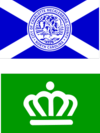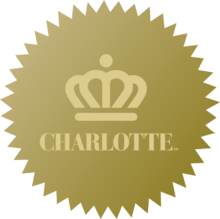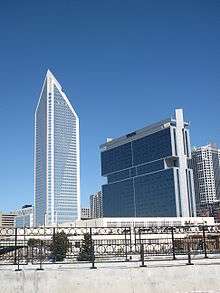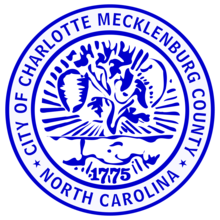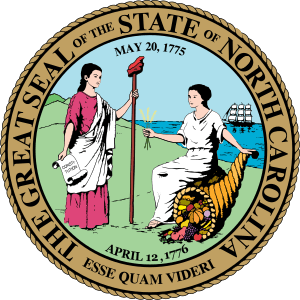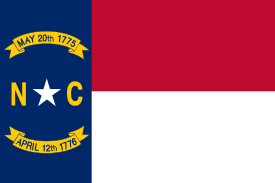Charlotte, North Carolina
Charlotte (/ˈʃɑːrlɪt/) is the most populous city in the U.S. state of North Carolina. Located in the Piedmont, it is the county seat of Mecklenburg County. In 2019, the U.S. Census Bureau estimated the population was 885,708,[6] making it the 15th-most populous city in the U.S. and the second-largest in the Southeast behind Jacksonville, Florida. The city is the cultural, economic, and transportation center of the Charlotte metropolitan area, whose population ranks 23rd in the U.S., and had a population of 2,569,213, in 2018.[5] The Charlotte metropolitan area is part of a sixteen-county market region or combined statistical area with a 2018 census-estimated population of 2,728,933.[7]
Charlotte | |
|---|---|
| City of Charlotte | |
 From top to bottom, left to right: Charlotte skyline, UNC Charlotte, NASCAR Hall of Fame, Spectrum Center, Bank of America Stadium, Romare Bearden Park | |
| Nicknames: The Queen City, The QC,The Gym City, The Hornet's Nest[1] | |
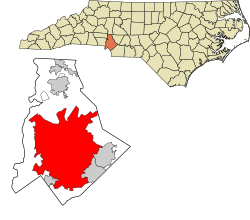 Location within Mecklenburg County | |
 Charlotte Location within North Carolina  Charlotte Location within the United States  Charlotte Location within North America | |
| Coordinates: 35°13′38″N 80°50′35″W[2] | |
| Country | |
| State | |
| County | |
| Metro | Charlotte–Concord–Gastonia |
| Settled | 1755 |
| Incorporated | 1768 |
| Named for | Charlotte of Mecklenburg-Strelitz |
| Government | |
| • Type | Council-manager |
| • Body | City Council of Charlotte, North Carolina |
| • Mayor | Vi Lyles (D) |
| Area | |
| • City | 309.25 sq mi (800.94 km2) |
| • Land | 307.26 sq mi (795.80 km2) |
| • Water | 1.98 sq mi (5.14 km2) |
| Elevation | 761 ft (232 m) |
| Population (2010) | |
| • City | 731,424 |
| • Estimate (2019)[4] | 885,708 |
| • Rank | 1st in North Carolina 15th in United States |
| • Density | 2,882.59/sq mi (1,112.98/km2) |
| • Urban | 1,249,442 (38th) |
| • Metro | 2,636,883 (23rd) |
| Demonym(s) | Charlottean |
| Time zone | UTC−5 (EST) |
| • Summer (DST) | UTC−4 (EDT) |
| ZIP code | 28201-28237, 28240-28247, 28250, 28253-28256, 28258, 28260-28262, 28265-28266, 28269-28275, 28277-28278, 28280-28290, 28296-28297, 28299 |
| Area codes | 704, 980 |
| FIPS code | 37-12000[5] |
| Major Airport | Charlotte Douglas International Airport |
| Rapid Transit | Charlotte Area Transit System |
| Website | charlottenc |
Between 2004 and 2014, Charlotte was ranked as the country's fastest-growing metro area, with 888,000 new residents.[8] Based on U.S. Census data from 2005 to 2015, Charlotte tops the U.S. in millennial population growth.[9] It is the second-largest city in the southeastern United States, just behind Jacksonville, Florida. It is the third-fastest-growing major city in the United States.[10] It is listed as a "gamma" global city by the Globalization and World Cities Research Network.[11] Residents are referred to as "Charlotteans".[12]
Charlotte is home to the corporate headquarters of Bank of America, Truist Financial, and the east coast operations of Wells Fargo, which along with other financial institutions has made it the second-largest banking center in the United States since 1995.[13]
Among Charlotte's many notable attractions, some of the most popular include the Carolina Panthers (NFL), the Charlotte Hornets (NBA), the NASCAR All-Star Race, the Wells Fargo Championship, the NASCAR Hall of Fame, the Charlotte Ballet, Children's Theatre of Charlotte, Carowinds amusement park, and the U.S. National Whitewater Center.
Charlotte has a humid subtropical climate. It is located several miles east of the Catawba River and southeast of Lake Norman, the largest man-made lake in North Carolina. Lake Wylie and Mountain Island Lake are two smaller man-made lakes located near the city.
History
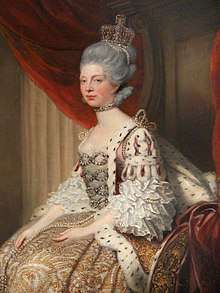
The Catawba Native Americans were the first known historic tribe to settle Mecklenburg County (in the Charlotte area) and were first recorded around 1567 in Spanish records. By 1759 half the Catawba tribe had died from smallpox, which was endemic among Europeans, because the Catawba had not acquired immunity to the new disease. At the time of their largest population, Catawba people numbered 10,000, but by 1826 their total population had dropped to 110.[14]
The European-American city of Charlotte was developed first by a wave of migration of Scots-Irish Presbyterians, or Ulster-Scot settlers from Northern Ireland, who dominated the culture of the Southern Piedmont Region. They made up the principal founding European population in the backcountry. German immigrants also settled the area before the American Revolutionary War, but in much smaller numbers. They still contributed greatly to the early foundations of the region.
Mecklenburg County was initially part of Bath County (1696 to 1729) of New Hanover Precinct, which became New Hanover County in 1729. The western portion of New Hanover split into Bladen County in 1734, its western portion splitting into Anson County in 1750. Mecklenburg County formed from Anson County in 1762. Further apportionment was made in 1792, after the American Revolutionary War, with Cabarrus County formed from Mecklenburg.[15]
In 1842, Union County formed from Mecklenburg's southeastern portion and a western portion of Anson County. These areas were all part of one of the original six judicial/military districts of North Carolina known as the Salisbury District.[16]
The area that is now Charlotte was settled by people of European descent around 1755, when Thomas Spratt and his family settled near what is now the Elizabeth neighborhood. Thomas Polk (granduncle of U.S. President James K. Polk), who later married Thomas Spratt's daughter, built his house by the intersection of two Native American trading paths between the Yadkin and Catawba rivers.[17] One path ran north–south and was part of the Great Wagon Road; the second path ran east–west along what is now Trade Street.
Nicknamed the "Queen City",[18] like its county a few years earlier, Charlotte was named in honor of German princess Charlotte of Mecklenburg-Strelitz, who had become the Queen Consort of Great Britain and Ireland in 1761, seven years before the town's incorporation. A second nickname derives from the American Revolutionary War, when British commander General Charles Cornwallis, 1st Marquess Cornwallis occupied the city but was driven out by hostile residents. He wrote that Charlotte was "a hornet's nest of rebellion", leading to the nickname "The Hornet's Nest".[19]
Within decades of Polk's settling, the area grew to become the Town of Charlotte, incorporating in 1768.[20] Though chartered as Charlotte, the name appears as a form of "Charlottesburgh" on many maps until around 1800.[21] The crossroads in the Piedmont became the heart of Uptown Charlotte. In 1770, surveyors marked the streets in a grid pattern for future development. The east–west trading path became Trade Street, and the Great Wagon Road became Tryon Street, in honor of William Tryon, a royal governor of colonial North Carolina.[22] The intersection of Trade and Tryon—commonly known today as "Trade & Tryon", or simply "The Square"[17]—is more properly called "Independence Square".[23]
While surveying the boundary between the Carolinas in 1772, William Moultrie stopped in Charlotte Town, whose five or six houses were "very ordinary built of logs".[24]
Local leaders came together in 1775 and signed the Mecklenburg Resolves, more popularly known as the Mecklenburg Declaration of Independence. While not a true declaration of independence from British rule, it is among the first such declarations that eventually led to the American Revolution. May 20, the traditional date of the signing of the declaration, is celebrated annually in Charlotte as "MecDec", with musket and cannon fire by reenactors in Independence Square. North Carolina's state flag and state seal also bear the date.
After the American Revolution
Charlotte is traditionally considered the home of Southern Presbyterianism, but in the 19th century, numerous churches, including Presbyterian, Baptist, Methodist, Episcopalian, Lutheran, and Roman Catholic formed, eventually giving Charlotte the nickname, "The City of Churches".[25]
In 1799, in nearby Cabarrus County, 12-year-old Conrad Reed found a 17- pound rock, which his family used as a doorstop. Three years later, a jeweler determined it was nearly solid gold, paying the family a paltry $3.50.[26] The first documented gold find in the United States of any consequence set off the nation's first gold rush. Many veins of gold were found in the area throughout the 19th and early 20th centuries, leading to the 1837 founding of the Charlotte Mint. North Carolina was the chief producer of gold in the United States until the Sierra Nevada find in 1848,[27] although the volume mined in the Charlotte area was dwarfed by subsequent rushes.
Some groups still pan for gold occasionally in local streams and creeks. The Reed Gold Mine operated until 1912. The Charlotte Mint was active until 1861, when Confederate forces seized it at the outbreak of the Civil War. The mint was not reopened at the war's end, but the building, albeit in a different location, now houses the Mint Museum of Art.
The city's first boom came after the Civil War, as a cotton processing center and a railroad hub. Charlotte's city population at the 1880 Census grew to 7,084.[28]
In 1910, Charlotte surpassed Wilmington to become North Carolina's largest city.[29]
World War I to present
The population grew again during World War I, when the U.S. government established Camp Greene, north of present-day Wilkinson Boulevard. Many soldiers and suppliers stayed after the war, launching urbanization that eventually overtook older cities along the Piedmont Crescent. In the 1920 census, Charlotte was only the state's second largest city, Winston-Salem having 48,395, two thousand more people than Charlotte. Charlotte overtook it several years later.[30]
The city's modern-day banking industry achieved prominence in the 1970s and 1980s, largely under the leadership of financier Hugh McColl. McColl transformed North Carolina National Bank (NCNB) into a formidable national bank that through aggressive acquisitions eventually merged with BankAmerica to become Bank of America. First Union, later Wachovia in 2001, experienced similar growth before it was acquired by San Francisco-based Wells Fargo in 2008. Measured by control of assets, Charlotte became the second largest banking headquarters in the United States after New York City.[31]
On September 22, 1989, the city was hit by Hurricane Hugo. With sustained winds of 69 mph (111 km/h) and gusts of 87 mph (140 km/h),[32] Hugo caused massive property damage, destroyed 80,000 trees, and knocked out electrical power to most of the population. Residents were without power for weeks, schools were closed for a week or more, and the cleanup took months. The city was caught unprepared; Charlotte is 200 miles (320 km) inland, and residents from coastal areas in both Carolinas often wait out hurricanes in Charlotte.
In December 2002, Charlotte and much of central North Carolina were hit by an ice storm that resulted in more than 1.3 million people losing power.[33] During an abnormally cold December, many were without power for weeks. Many of the city's Bradford pear trees split apart under the weight of the ice.
In August 2015 and September 2016, the city experienced several days of protests related to the police shootings of Jonathan Ferrell and Keith Scott.[34][35]
Geography
According to the United States Census Bureau, the city has a total area of 308.6 square miles (799 km2), of which 306.6 square miles (794 km2) is land and 2.0 square miles (5.2 km2) is water.[36] Charlotte lies at an elevation of 751 feet (229 m). Charlotte constitutes most of Mecklenburg County in the Carolina Piedmont. Charlotte center city sits atop a long rise between two creeks, Sugar Creek and Irwin Creek, and was built on the gunnies of the St. Catherine's and Rudisill gold mines.
Though the Catawba River and its lakes lie several miles west, there are no significant bodies of water or other geological features near the city center. Consequently, development has neither been constrained nor helped by waterways or ports that have contributed to many cities of similar size. The lack of these obstructions has contributed to Charlotte's growth as a highway, rail, and air transportation hub.
Cityscape
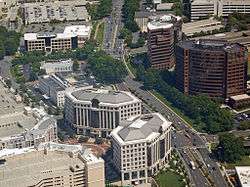
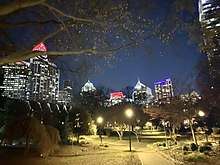
Charlotte has 199 neighborhoods radiating in all directions from Uptown.[37] Biddleville, the primary historic center of Charlotte's African American community, is west of Uptown, starting at the Johnson C. Smith University campus and extending to the airport.[38] East of The Plaza and north of Central Avenue, Plaza-Midwood is known for its international population, including Eastern Europeans, Greeks, Middle-Easterners, and Hispanics.[39] North Tryon and the Sugar Creek area include several Asian American communities. NoDa (North Davidson), north of Uptown, is an emerging center for arts and entertainment.[40] Myers Park, Dilworth, and Eastover are home to some of Charlotte's oldest and largest houses, on tree-lined boulevards, with Freedom Park nearby.[41]
The SouthPark area offers shopping, dining, and multifamily housing. Far South Boulevard is home to a large Hispanic community. Many students, researchers, and affiliated professionals live near UNC Charlotte in the northeast area known as University City.[42]
The large area known as Southeast Charlotte is home to many golf communities, luxury developments, churches, the Jewish community center, and private schools. As undeveloped land within Mecklenburg has become scarce, many of these communities have expanded into Weddington and Waxhaw in Union County.[43] Ballantyne, in the south of Charlotte, and nearly every area on the I‑485 perimeter, has experienced rapid growth over the past ten years.
Since the 1980s in particular, Uptown Charlotte has undergone massive construction of buildings, housing Bank of America, Wells Fargo, Hearst Corporation, Duke Energy, several hotels, and multiple condominium developments.[44]
Green space

The 120‑acre Park Road Park is a prominent landmark near the SouthPark area.[45] Park Road Park features eight basketball courts, two horseshoe pits, six baseball fields, five picnic shelters, volleyball courts, playgrounds, trails, tennis courts, and an eleven-acre lake.[46] The Charlotte-Mecklenburg Parks & Recreation Department operates 36 tennis facilities and the 12 lighted tennis courts at the park.[47]
The urban section of Little Sugar Creek Greenway was completed in 2012. Inspired in part by the San Antonio River Walk, and integral to Charlotte's extensive urban park system, it is "a huge milestone" according to Gwen Cook, greenway planner for Mecklenburg County Park and Recreation.[48] However, the Little Sugar Creek Greenway bears no relation to the San Antonio River Walk. The Little Sugar Creek Greenway is prone to flooding during thunderstorms and periods of heavy rain. Creation of Little Sugar Creek Greenway cost $43 million and was controversial because it required the forced acquisition of several established local businesses.
The city of Charlotte and Mecklenburg County began purchasing flood-prone homes in the 1990s. Voluntary buyouts of 700 households have created around 200 acres of open land that can flood safely, thereby saving an estimated $28 million in flood damage and emergency rescues.[49]
Climate
Charlotte, like much of the Piedmont region of the southeastern United States, has a humid subtropical climate (Köppen Cfa), with four distinct seasons; the city itself is part of USDA hardiness zone 8a, transitioning to 7b in the suburbs in all directions except the south.[50] Winters are cool to mild, with a normal January daily mean temperature of 40.1 °F (4.5 °C).[51] On average, there are 59 nights per year that drop to or below freezing, and only 1.5 days that fail to rise above freezing.[51] April is the driest month, with an average of 3.04 inches (7.7 cm) of precipitation. Summers are hot and humid, with a normal July daily mean temperature of 78.5 °F (25.8 °C).[51] There is an average 44 days per year with highs at or above 90 °F (32 °C).[51] Official record temperatures range from 104 °F (40 °C) recorded six times, most recently from June 29 to July 1, 2012, down to −5 °F (−21 °C) recorded on January 21, 1985, the most recent of three occasions. The record cold daily maximum is 14 °F (−10 °C) on February 12 and 13, 1899,[51] and the record warm daily minimum is 82 °F (28 °C) on August 13, 1881.[lower-alpha 1] The average window for freezing temperatures is November 5 through March 30, allowing a growing season of 220 days.[51]
Charlotte is directly in the path of subtropical moisture from the Gulf of Mexico as it heads up the eastern seaboard, thus the city receives ample precipitation throughout the year but also many clear, sunny days; precipitation is generally less frequent in autumn than in spring.[51] On average, Charlotte receives 41.6 inches (1,060 mm) of precipitation annually, which is somewhat evenly distributed throughout the year, although summer is slightly wetter; annual precipitation has historically ranged from 26.23 in (666 mm) in 2001 to 68.44 in (1,738 mm) in 1884.[51] In addition, there is an average of 4.3 inches (10.9 cm) of snow, mainly in January and February and rarely December or March, with more frequent ice storms and sleet mixed in with rain; seasonal snowfall has historically ranged from trace amounts as recently as 2011–12 to 22.6 in (57 cm) in 1959–60.[51] These storms can have a major impact on the area, as they often pull tree limbs down onto power lines and make driving hazardous. Snow has been recorded a small number of times in April, most recently, April 2, 2019.
| Climate data for Charlotte, North Carolina (Charlotte-Douglas Int'l), 1981–2010 normals,[lower-alpha 2] extremes 1878–present[lower-alpha 3] | |||||||||||||
|---|---|---|---|---|---|---|---|---|---|---|---|---|---|
| Month | Jan | Feb | Mar | Apr | May | Jun | Jul | Aug | Sep | Oct | Nov | Dec | Year |
| Record high °F (°C) | 79 (26) |
82 (28) |
91 (33) |
96 (36) |
98 (37) |
104 (40) |
104 (40) |
104 (40) |
104 (40) |
99 (37) |
85 (29) |
80 (27) |
104 (40) |
| Mean maximum °F (°C) | 69.7 (20.9) |
72.8 (22.7) |
81.1 (27.3) |
86.3 (30.2) |
90.0 (32.2) |
94.4 (34.7) |
96.9 (36.1) |
96.0 (35.6) |
91.1 (32.8) |
84.9 (29.4) |
78.0 (25.6) |
70.4 (21.3) |
98.0 (36.7) |
| Average high °F (°C) | 50.7 (10.4) |
55.0 (12.8) |
63.1 (17.3) |
71.9 (22.2) |
78.9 (26.1) |
86.0 (30.0) |
89.0 (31.7) |
87.5 (30.8) |
81.3 (27.4) |
71.8 (22.1) |
62.4 (16.9) |
52.9 (11.6) |
70.9 (21.6) |
| Average low °F (°C) | 29.6 (−1.3) |
32.7 (0.4) |
39.3 (4.1) |
46.9 (8.3) |
55.8 (13.2) |
64.5 (18.1) |
68.1 (20.1) |
67.2 (19.6) |
60.4 (15.8) |
48.8 (9.3) |
39.2 (4.0) |
31.9 (−0.1) |
48.7 (9.3) |
| Mean minimum °F (°C) | 14.2 (−9.9) |
18.7 (−7.4) |
24.2 (−4.3) |
32.9 (0.5) |
43.3 (6.3) |
55.9 (13.3) |
62.0 (16.7) |
60.6 (15.9) |
48.7 (9.3) |
34.6 (1.4) |
25.4 (−3.7) |
18.0 (−7.8) |
11.3 (−11.5) |
| Record low °F (°C) | −5 (−21) |
−5 (−21) |
4 (−16) |
21 (−6) |
32 (0) |
45 (7) |
53 (12) |
50 (10) |
38 (3) |
24 (−4) |
11 (−12) |
−5 (−21) |
−5 (−21) |
| Average precipitation inches (mm) | 3.41 (87) |
3.32 (84) |
4.01 (102) |
3.04 (77) |
3.18 (81) |
3.74 (95) |
3.68 (93) |
4.22 (107) |
3.24 (82) |
3.40 (86) |
3.14 (80) |
3.25 (83) |
41.63 (1,057) |
| Average snowfall inches (cm) | 2.1 (5.3) |
1.2 (3.0) |
0.6 (1.5) |
0 (0) |
0 (0) |
0 (0) |
0 (0) |
0 (0) |
0 (0) |
0 (0) |
0.1 (0.25) |
0.3 (0.76) |
4.3 (11) |
| Average precipitation days (≥ 0.01 in) | 9.7 | 9.4 | 9.6 | 8.8 | 9.6 | 10.2 | 10.8 | 9.8 | 7.1 | 6.9 | 8.4 | 9.6 | 109.9 |
| Average snowy days (≥ 0.1 in) | 1.0 | 0.5 | 0.2 | 0 | 0 | 0 | 0 | 0 | 0 | 0 | 0 | 0.2 | 1.9 |
| Average relative humidity (%) | 65.7 | 61.8 | 61.5 | 59.3 | 66.9 | 69.6 | 72.2 | 73.5 | 73.3 | 69.9 | 67.6 | 67.3 | 67.4 |
| Average dew point °F (°C) | 27.3 (−2.6) |
28.6 (−1.9) |
36.3 (2.4) |
43.5 (6.4) |
54.9 (12.7) |
63.0 (17.2) |
67.1 (19.5) |
66.7 (19.3) |
61.2 (16.2) |
49.5 (9.7) |
39.6 (4.2) |
31.3 (−0.4) |
47.4 (8.6) |
| Mean monthly sunshine hours | 173.3 | 180.3 | 234.8 | 269.6 | 292.1 | 289.2 | 290.0 | 272.9 | 241.4 | 230.5 | 178.4 | 168.5 | 2,821 |
| Percent possible sunshine | 55 | 59 | 63 | 69 | 67 | 66 | 66 | 65 | 65 | 66 | 58 | 55 | 63 |
| Average ultraviolet index | 3 | 4 | 6 | 8 | 9 | 10 | 10 | 9 | 8 | 5 | 3 | 2 | 6 |
| Source 1: NOAA (relative humidity and sun 1961–1990)[51][52][53] | |||||||||||||
| Source 2: Weather Atlas [54] (UV index) | |||||||||||||
Demographics
| Historical population | |||
|---|---|---|---|
| Census | Pop. | %± | |
| 1850 | 1,065 | — | |
| 1860 | 2,265 | 112.7% | |
| 1870 | 4,473 | 97.5% | |
| 1880 | 7,094 | 58.6% | |
| 1890 | 11,557 | 62.9% | |
| 1900 | 18,091 | 56.5% | |
| 1910 | 34,014 | 88.0% | |
| 1920 | 46,338 | 36.2% | |
| 1930 | 82,675 | 78.4% | |
| 1940 | 100,899 | 22.0% | |
| 1950 | 134,042 | 32.8% | |
| 1960 | 201,564 | 50.4% | |
| 1970 | 241,420 | 19.8% | |
| 1980 | 315,474 | 30.7% | |
| 1990 | 395,934 | 25.5% | |
| 2000 | 540,828 | 36.6% | |
| 2010 | 731,424 | 35.2% | |
| Est. 2019 | 885,708 | [4] | 21.1% |
| [55] | |||
The most recent U.S. Census estimate (2019, released in May 2020) showed 885,708 residents living within Charlotte's city limits[6] and 1,093,901 in Mecklenburg County.[56] The combined statistical area, or trade area, of Charlotte–Concord–Gastonia, NC–SC had a population of 2,728,933.[56] Figures from the more comprehensive 2010 census show Charlotte's population density to be 2,457 per square mile (948.7/km2). There were 319,918 housing units at an average density of 1,074.6 per square mile (414.9/km2).[57]
.png)
According to the 2010 United States Census, the racial composition of Charlotte was 45.1% White or Caucasian, 35.0% Black or African American, 13.1% Hispanic or Latin American, 5.0% Asian, 0.5% American Indian, 0.1% Native Hawaiian or Other Pacific Islander, 6.8% some other race, and 2.7% two or more races.
In 1970, the Census Bureau reported Charlotte's population as 30.2% Black and 68.9% White.[58]
The median income for a household in the city was $48,670, and the median income for a family was $59,452. Males had a median income of $38,767 versus $29,218 for females. The per capita income for the city was $29,825. The percentage of the population living at or below the poverty line was 10.6%, with 7.8% of families living at or below the poverty line. Out of the total population, 13.8% of those under the age of 18 and 9.7% of those 65 and older were living below the poverty line.
Religion
Charlotte has historically been a Protestant city. It is the birthplace of Billy Graham, and is also the historic seat of Southern Presbyterianism, but the changing demographics of the city's increasing population have brought scores of new denominations and faiths. The Billy Graham Evangelistic Association, Wycliffe Bible Translators' JAARS Center, SIM Missions Organization, and The Christian Research Institute make their homes in the Charlotte general area. In total, Charlotte proper has over 700 places of worship.
The Presbyterian Church (USA) is now the fourth largest denomination in Charlotte, with 68,000 members and 206 congregations. The second largest Presbyterian denomination, the Presbyterian Church in America has 43 churches and 12,000 members, followed by the Associate Reformed Presbyterian Church with 63 churches and 9,500 members.[59]
The Baptist Peace Fellowship of North America is headquartered in Charlotte, and both Reformed Theological Seminary and Gordon-Conwell Theological Seminary have campuses there; more recently, the religious studies academic departments of Charlotte's local colleges and universities have also grown considerably.
The Advent Christian Church is headquartered in Charlotte.
The Western North Carolina Annual Conference of the United Methodist Church is headquartered in Charlotte.
The largest Protestant church in Charlotte, by attendance, is Elevation Church, a Southern Baptist church founded by lead pastor Steven Furtick. The church has over 15,000 congregants at nine Charlotte locations.[60]
Charlotte's Cathedral of Saint Patrick is the seat of the bishop of the Roman Catholic Diocese of Charlotte. The Traditional Latin Mass is offered by the Society of St. Pius X at St. Anthony Catholic Church in nearby Mount Holly. The Traditional Latin Mass is also offered at St. Ann, Charlotte, a church under the jurisdiction of the Roman Catholic Bishop of Charlotte. St. Matthew Parish, located in the Ballantyne neighborhood, is the largest Catholic parish with over 30,000 parishioners.[61]
The Greek Orthodox Church's cathedral for North Carolina, Holy Trinity Cathedral, is located in Charlotte.[62]
_-_view_from_Mint_Museum.jpg)
Charlotte has the largest Jewish population in the Carolinas. Shalom Park in south Charlotte is the hub of the Jewish community, featuring two synagogues, Temple Israel and Temple Beth El, as well as a community center, the Charlotte Jewish Day School for grades K–5, and the headquarters of the Charlotte Jewish News.[63]
Most African Americans in Charlotte are Baptists affiliated with the National Baptist Convention, the largest predominantly African American denomination in the United States. African American Methodists are largely affiliated with either the African Methodist Episcopal Zion Church, headquartered in Charlotte, or the African Methodist Episcopal Church. African American Pentecostals are represented by several organizations such as the United House of Prayer for All People, Church of God in Christ, and the United Holy Church of America.
As of 2013, 51.91% of people in Charlotte practice religion on a regular basis, making it the second most religious city in North Carolina after Winston-Salem. The largest religion in Charlotte is Christianity, with Baptists (13.26%) having the largest number of adherents. The second largest Christian group are the Roman Catholics (9.43%), followed by Methodists (8.02%) and Presbyterians (5.25%). Other Christian affiliates include Pentecostals (2.50%), Lutherans (1.30%), Episcopalians (1.20%), Latter-Day Saints (0.84%), and other Christian (8.87%) churches, including the Eastern Orthodox and non-denominational congregations. Judaism (0.57%) is the second largest religion after Christianity, followed by Eastern religions (0.34%) and Islam (0.32%).[64]
Economy

Charlotte is the second-largest banking center in the United States, after New York City.[65][66] The nation's second largest financial institution by total assets, Bank of America, calls the city home.[67] It is also home to the nation's sixth largest financial institution, Truist, formed from the merger of BB&T and SunTrust in 2019.[68] The city was also the former corporate home of Wachovia until its 2008 acquisition by Wells Fargo; Wells Fargo integrated legacy Wachovia, with the two banks fully merged at the end of 2011, which included transitioning all of the Wachovia branches in the Carolinas to Wells Fargo branches by October 2011. Since then, Charlotte has become the regional headquarters for East Coast operations of Wells Fargo, which is headquartered in San Francisco, California. Charlotte also serves as the headquarters for Wells Fargo's capital markets activities including sales and trading, equity research, and investment banking. Bank of America's headquarters, along with other regional banking and financial services companies, are located primarily in the Uptown central business district. Microsoft and Centene Corporation also operate their East Coast headquarters in Charlotte.[69][70][71]
As of 2019, Charlotte has seven Fortune 500 companies in its metropolitan area. Listed in order of their rank, they are: Bank of America, Honeywell, Nucor, Lowe's, Duke Energy, Sonic Automotive and Brighthouse Financial.[72] The Charlotte area includes a diverse range of businesses, including foodstuffs such as Harris Teeter, Snyder's-Lance, Carolina Foods Inc, Bojangles', Food Lion, Compass Group USA, and Coca-Cola Bottling Co. Consolidated (Charlotte being the nation's second largest Coca-Cola bottler); packaging company Sealed Air, financial services company Dixon Hughes Goodman, chemical company Albemarle Corporation, door and window maker JELD-WEN, motor and transportation companies such as RSC Brands, Continental Tire the Americas, LLC., Meineke Car Care Centers, Carlisle Companies (along with several other services); retail companies Belk, Cato Corporation and Rack Room Shoes, along with a wide array of other businesses.[73]
Charlotte is the major center of the U.S. motorsports industry, housing the US's only Formula One team, Haas F1, multiple teams and offices of NASCAR, the NASCAR Hall of Fame, and Charlotte Motor Speedway in Concord. Approximately 75% of the NASCAR industry's race teams, employees and drivers are based nearby. The large presence of the racing technology industry and the newly built NHRA dragstrip, zMAX Dragway at Concord, are influencing other top professional drag racers to move their shops to Charlotte as well.
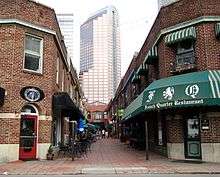
Located in the western part of Mecklenburg County is the U.S. National Whitewater Center, which consists of man-made rapids of varying degrees, and is open to the public year-round.[74]
The Charlotte Region has a major base of energy-oriented organizations and has become known as "Charlotte USA – The New Energy Capital". In the region there are more than 240 companies directly tied to the energy sector, collectively employing more than 26,400. Since 2007 more than 4,000 energy sector jobs have been announced. Major energy players in Charlotte include AREVA, Duke Energy, Electric Power Research Institute, Fluor, Metso Power, Piedmont Natural Gas, Albemarle Corp, Siemens Energy, Shaw Group, Toshiba, URS Corp., and Westinghouse. The University of North Carolina at Charlotte has a reputation in energy education and research, and its Energy Production and Infrastructure Center (EPIC) trains energy engineers and conducts research.[75]
The area is an increasingly growing trucking and freight transportation hub for the East Coast. The Charlotte Center city has seen remarkable growth over the last decade. Numerous residential units continue to be built uptown, including over 20 skyscrapers under construction, recently completed, or in the planning stage. Many new restaurants, bars and clubs now operate in the Uptown area. Several projects are transforming the Midtown Charlotte/Elizabeth area.[76]
In 2013, Forbes named Charlotte among its list of Best Places for Business and Careers.[77] Charlotte was listed as the 20th largest city in the US, and the 60th fastest growing city in the US between 2000 and 2008.[78]
| Name | Industry | Number of employees |
|---|---|---|
| 1. Atrium Health | Health Care and Social Assistance | 35,700 |
| 2. Charlotte-Mecklenburg Schools | Educational Services | 18,495 |
| 3. Bank of America | Finance and Insurance | 15,000 |
| 4. Duke Energy | Utilities | 7,900 |
| 5. City of Charlotte | Public Administration | 6,800 |
| 6. Mecklenburg County Government | Public Administration | 5,512 |
| 7. Carowinds | Arts, Entertainment and Recreation | 4,100 |
| 8. University of North Carolina at Charlotte | Educational Services | 4,000 |
| 9. Central Piedmont Community College | Educational Services | 2,700 |
| 10. Belk | Retail Trade | 2,300 |
| 11. Bojangles' Famous Chicken 'n Biscuits | Accommodation and Food Services | 1,892 |
| 12. Carolina Restaurant Group | Accommodation and Food Services | 1,866 |
| 13. Hendrick Automotive Group | Retail Trade | 1,723 |
| 14. Sealed Air | Manufacturing | 1,400 |
| 15. Snyder's-Lance | Manufacturing | 1,280 |
| 16. Coca-Cola Bottling Co. Consolidated | Manufacturing | 1,210 |
| 17. Charlotte Pipe & Foundry Co. | Manufacturing | 1,200 |
| 18. U.S. National Whitewater Center | Arts, Entertainment and Recreation | 1,000 |
| 18. AvidXChange Inc. | Professional Services | 1,000 |
| 20. OrthoCarolina | Health Care and Social Assistance | 936 |
Arts and culture
Museums
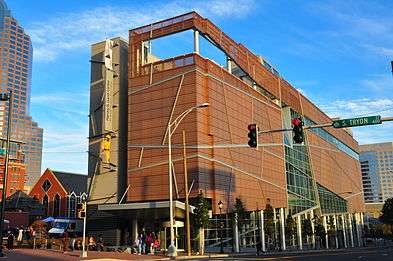
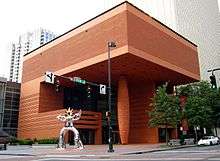
- Bechtler Museum of Modern Art[80]
- Billy Graham Library[81]
- Carolinas Aviation Museum[82]
- Charlotte-Mecklenburg Fire Education Center and Museum
- Charlotte Nature Museum in Freedom Park
- Charlotte Trolley Museum in Historic South End
- Discovery Place
- Discovery Place KIDS-Huntersville
- Harvey B. Gantt Center for African-American Arts + Culture[83]
- Historic Rosedale Plantation
- Levine Museum of the New South[84]
- The Light Factory[85]
- McColl Center for Art + Innovation[86]
- Mint Museum[87]
- NASCAR Hall of Fame[88]
- Second Ward Alumni House Museum[89]
- Wells Fargo History Museum
- Charlotte Museum of History[90]
Performing arts
- Actor's Theatre of Charlotte[91]
- Amos' Southend Music Hall
- Blumenthal Performing Arts Center
- Charlotte Ballet[92]
- Charlotte Symphony Orchestra
- Charlotte Shakespeare
- ImaginOn[93]
- North Carolina Music Factory
- Opera Carolina[94]
- The Robot Johnson Show
- Citizens of the Universe
- Theatre Charlotte
- Carolina Renaissance Festival
Festivals and events
The Charlotte region is home to many annual festivals and special events. The Carolina Renaissance Festival operates on Saturdays and Sundays each October and November. Located near the intersection of Highway 73 and Poplar Tent Road, the Carolina Renaissance Festival is one of the largest renaissance themed events in the country. It features 11 stages of outdoor variety entertainment, a 22-acre village marketplace, an interactive circus, an arts and crafts fair, a jousting tournament, and a feast, all rolled into one non-stop, day-long family adventure.[95]
The Yiasou Greek Festival is an award-winning Greek Festival. It began in 1978 and since then has become one of Charlotte's largest cultural events.[96] The Yiasou (the Greek word for Hello, Goodbye and Cheers) Greek Festival features Hellenic cultural exhibits, authentic Greek cuisine and homemade pastries, entertainment, live music and dancing, wine tastings, art, shopping and more.[97]
Taste of Charlotte is a three-day festival offering samples from area restaurants, live entertainment and children's activities. Located on Tryon Street, Taste of Charlotte spans six city blocks from Stonewall to 5th Street.[98]
Moo and Brew Fest is an annual craft beer and burger festival that is the largest in North Carolina, held each April and includes various national musical acts.[99]
Breakaway Music Festival is a music festival which takes place at the NC Music Factory and consists of hip hop and electronic music artists and DJs.[100]
Heroes Convention is an annual comic book convention held in June at the Charlotte Convention Center. Founded in 1982, it is one of the oldest and largest independent comic book conventions in the United States [101]
Charlotte Pride is an annual LGBT event held in August. In 2019, the event attracted 200,000 people to Uptown Charlotte.[102] The event's parade became Charlotte's largest annual parade in 2017 and the largest of its kind in North Carolina.[103]
Zoos and aquariums
Charlotte is "... the largest metropolitan area in the United States without a zoo".[104] The Charlotte Zoo initiative is a proposal to allocate 250 acres (101 ha) of natural North Carolina land to be dedicated to the zoological foundation, which was incorporated in 2008. On August 18, 2012, News Channel 14 says that the initiative is "... still a few years away" and the plot of land is "... just seven miles from the center of uptown". According to the news channel, "... the zoo will cost roughly $300 million, and will be completely privately-funded."[105] The Charlotte Observer references two other zoos, the Riverbanks Zoo and Garden and the North Carolina Zoological Park as two "great zoos" that are accessible from the Charlotte-Mecklenberg area, both roughly more than 70 miles away.[106]
Charlotte is also served by the Sea Life Charlotte-Concord Aquarium in the nearby city of Concord. The aquarium is 30,000 square feet in size, and is part of the Concord Mills mall. The aquarium opened on February 20, 2014.[107]
Libraries

The Charlotte Mecklenburg Library serves the Charlotte area with a large collection (more than 1.5 million) of books, CDs and DVDs at 15 locations in the city of Charlotte, with branches in the surrounding towns of Matthews, Mint Hill, Huntersville, Cornelius and Davidson. All locations provide free access to Internet-enabled computers and WiFi, and a library card from one location is accepted at all 20 locations.[108]
Although the library's roots go back to the Charlotte Literary and Library Association, founded on January 16, 1891,[109] the state-chartered Carnegie Library, which opened on the current North Tryon site of the Main Library, was the first non-subscription library opened to members of the public in the city of Charlotte. The philanthropist Andrew Carnegie donated $25,000 for a library building, on the condition that the city of Charlotte donate a site and $2,500 per year for books and salaries,[110] and that the state grant a charter for the library. All conditions were met, and the Charlotte Carnegie Library opened in an imposing classical building on July 2, 1903.
The 1903 state charter also required that a library be opened for the disenfranchised African-American population of Charlotte. This was completed in 1905 with the opening of the Brevard Street Library for Negroes, an independent library in Brooklyn, a historically black area of Charlotte, on the corner of Brevard and East Second Streets (now Martin Luther King Boulevard).[111] The Brevard Street Library was the first library for African Americans in the state of North Carolina,[111] and some sources say in the southeast.[112] The library was closed in 1961 when the Brooklyn neighborhood in Second Ward was redeveloped, but its role as a cultural center for African-Americans in Charlotte is continued by the Beatties Ford and West Boulevard branches of the library system, as well as by Charlotte's African-American Cultural Center.
Sports
Charlotte is home to three major professional sports franchises: the Carolina Panthers of the National Football League (NFL), the Charlotte Hornets of the National Basketball Association (NBA), and Charlotte FC, a future team in Major League Soccer (MLS).[113][114] The Panthers have been located in Charlotte since the team's creation in 1995, and the current Hornets franchise has been located in Charlotte since its creation in 2004. The Panthers play their home games in Bank of America Stadium, while the Hornets play in the Spectrum Center.[115] The Panthers have won six division titles from (1996, 2003, 2008, 2013, 2014, 2015) and two NFC championships in 2003 and 2015.[116] Carolina has reached the Super Bowl twice but has been unsuccessful in both losing to the New England Patriots in Super Bowl XXXVIII in 2004 and against the Denver Broncos in Super Bowl 50 in 2016. The original Hornets NBA franchise was established in 1988 as an expansion team, but it relocated to New Orleans, Louisiana in 2002 after animosity grew between the team's fans and principal owner George Shinn.[117] The NBA quickly granted Charlotte an expansion franchise following the departure of the Hornets, and the new franchise, the Charlotte Bobcats, began to play in 2004.[118] The team retook the Hornets name when the New Orleans-based team renamed itself the New Orleans Pelicans in 2013.[119] The name change became official on May 20, 2014.[120] On the same day, the franchise reclaimed the history and records of the original 1988–2002 Hornets.[121] MLS awarded its expansion team to Charlotte in 2019 and it is set to begin play in 2022.[122]
Charlotte is represented in ice hockey and baseball at the 'AAA' professional level by the Charlotte Checkers and the Charlotte Knights. The Carolina Panthers were established by Jerry Richardson and several partners, mostly local business owners. In fall 2017, Jerry Richardson put the franchise up for sale, and in May 2018, billionaire businessman David Tepper purchased the team.[123]
The city is also the home of the National Junior College Athletic Association (NJCAA) headquarters. The NJCAA is the second-largest national intercollegiate athletic organization in the United States with over 500 member schools in 43 states.[124] The Big South Conference is also headquartered in Charlotte. Founded in 1983, the Big South Conference has 11 member institutions with over 19 different sports and completes in the NCAA's Division I.[125]
Over the years, Charlotte has hosted many international, collegiate, and professional sporting events. In professional basketball, the city hosted the NBA All-Star Game twice in 1991 and most recently in 2019.[126] In collegiate sports, Charlotte hosts the ACC Championship Game. The city has also been the host many ACC Men's Basketball Tournaments most recently in 2019.[127] In 2017, Charlotte hosted the PGA Championship at the Quail Hollow Club.[128]
Since 1931, Jim Crockett Promotions has been a full-fledged professional wrestling performer, based in the North Carolina, South Carolina, and Virginia states, and has been called Mid-Atlantic Wrestling. National Wrestling Alliance, World Championship Wrestling, WWE has big matches, and many pay-per-view event. Many professional wrestlers living.
The city is home to one university that participates in NCAA Division I Athletics, which are the Charlotte 49ers and are the teams that represent the University of North Carolina at Charlotte. Charlotte has participated in 11 NCAA Men's Basketball tournaments, 14 NCAA Men's Soccer Tournaments, and the Football team participated in their first bowl game in 2019 just six years after starting their program.
Johnson C. Smith University and Queens University of Charlotte both participate at the NCAA Division II level. Johnson and Wales University participate in the USCAA
Government
Charlotte has a council-manager form of government. The mayor and city council are elected every two years, with no term limits. The mayor is ex officio chair of the City Council, and only votes in case of a tie. Unlike other mayors in council-manager systems, Charlotte's mayor has the power to veto ordinances passed by the Council; vetoes can be overridden by a two-thirds majority of the Council. The Council appoints a city manager to serve as chief administrative officer.
Unlike some other cities and towns in North Carolina, elections are held on a partisan basis. Vi Lyles, a Democrat elected in 2017, became the 59th mayor of Charlotte, North Carolina. She is in her second term.[129]
Patrick Cannon, a Democrat, was sworn in as mayor on December 2, 2013.[130] On March 26, 2014, Cannon was arrested on public corruption charges. Later the same day, he resigned as mayor.[131] Mayor Pro Temp Michael Barnes served as Acting Mayor until April 7, when the City Council selected State Senator Dan Clodfelter, also a Democrat, to serve the remainder of Cannon's term.[132] Former Mecklenburg County Commission chairwoman Jennifer Roberts defeated Clodfelter in the 2015 Democratic primary and went on to win the general election, becoming the first Democratic woman to be elected to the post. She was ousted in the 2017 Democratic primary by Mayor Pro Tem Vi Lyles, who later defeated Republican City Councilman Kenny Smith in the general election to become Mayor of Charlotte.[133]
Historically, voters have been friendly to moderates of both parties. However, in recent years, Charlotte has swung heavily to the Democrats. Republican strength is concentrated in the southeastern portion of the city, while Democratic strength is concentrated in the south-central, eastern, and northern areas.
The city council comprises 11 members (7 from districts and 4 at-large). Democrats control the council with a 9-to-2 advantage, winning all 4 of the at-large seats in the November 2013, 2015, and 2017 municipal elections. While the City Council is responsible for passing ordinances, the City's budget, and other policies, all decisions can be overridden by the North Carolina General Assembly, since North Carolina municipalities do not have home rule. While municipal powers have been broadly construed since the 1960s, the General Assembly still retains considerable authority over local matters.
Charlotte is split between two congressional districts on the federal level. The southeastern portion is part of the 9th District, represented by Republican Dan Bishop. Most of the city is in the 12th District, represented by Democrat Alma Adams.
Charlotte was selected in 2011 to host the 2012 Democratic National Convention, which was held at the Spectrum Center. It began September 4, 2012, and ended on September 6, 2012. In 2018, Charlotte was chosen to host the Republican National Convention in August 2020.[134]
Education
School system
The city's public school system, Charlotte-Mecklenburg Schools, is the 2nd largest in North Carolina and 17th largest in the nation.[135] In 2009, it won the NAEP Awards, the Nation's Report Card for urban school systems with top honors among 18 city systems for 4th grade math, 2nd place among 8th graders.[136][137] An estimated 144,000 students are taught in 164 separate elementary, middle, and high schools.[138]
Colleges and universities
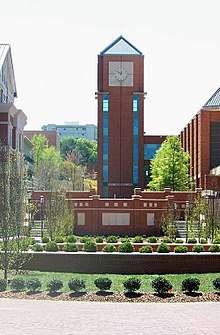
Charlotte is home to a number of universities and colleges such as Central Piedmont Community College, Johnson C. Smith University, Johnson & Wales University, Queens University of Charlotte, and the University of North Carolina at Charlotte. Several notable colleges are located in the metropolitan suburbs. Located in Davidson, North Carolina, Davidson College is ranked in the top ten nationally among liberal arts colleges, according to U.S. News & World Report.[139] Additional colleges in the area include Belmont Abbey College in the suburb of Belmont, North Carolina, Gaston College with its main campus in the suburb of Dallas, North Carolina and Wingate University in the suburb of Wingate, North Carolina. Also nearby are Winthrop University, Clinton Junior College, York Technical College in Rock Hill, South Carolina, and Gardner-Webb University in Boiling Springs, North Carolina in the westernmost part of the Charlotte area.
UNC Charlotte is the city's largest university. It is located in University City, the northeastern portion of Charlotte, which is also home to University Research Park, a 3,200 acres (13 km2) research and corporate park. With more than 29,000 students, UNC Charlotte is the third largest university in the state system.[140]
Central Piedmont Community College is the largest community college in the Carolinas, with more than 70,000 students each year and 6 campuses throughout the Charlotte-Mecklenburg region.[141] CPCC is part of the statewide North Carolina Community College System.
The Charlotte School of Law opened its doors in Charlotte in 2006 and was fully accredited by the American Bar Association in 2011. The law school offered the Juris Doctor degree but the Bar association rescinded the accreditation in 2017. Charlotte School of Law, once the largest law school in the Carolinas, has ceased to operate.[142]
Pfeiffer University has a satellite campus in Charlotte. Wake Forest University, with its main campus in Winston-Salem, North Carolina, also operates a satellite campus of its Babcock Graduate School of Management in the Uptown area.[143] The Connecticut School of Broadcasting, DeVry University, and ECPI University all have branches in Charlotte. The Universal Technical Institute has the NASCAR Technical Institute in nearby Mooresville, serving the Charlotte area. Montreat College (Charlotte) maintains a School of Professional and Adult Studies in the city. Additionally, Union Presbyterian Seminary has a non-residential campus offering the Master of Arts in Christian Education, and the Master of Divinity in Charlotte near the Beverley Woods area.
The North Carolina Research Campus, a 350-acre biotechnology hub located northeast of Charlotte in the city of Kannapolis, is a public-private venture including eight universities, one community college, the David H. Murdock Research Institute (DHMRI), the U.S. Department of Agriculture (USDA) and corporate entities that collaborate to advance the fields of human health, nutrition and agriculture. Partnering educational organizations include UNC Charlotte and Rowan-Cabarrus Community College, from the Charlotte region, as well as Appalachian State University, University of North Carolina at Chapel Hill, Duke University, University of North Carolina at Greensboro, North Carolina A&T State University, Shaw University, North Carolina Central University and North Carolina State University.[144] The research campus is part of a larger effort by leaders in the Charlotte area to attract energy, health, and other knowledge-based industries that contribute to North Carolina's strength in biotechnology.
Libraries

The Charlotte Mecklenburg Library serves the Charlotte area with a large collection (more than 1.5 million) of books, CDs and DVDs at 15 locations in the city of Charlotte, with branches in the surrounding towns of Matthews, Mint Hill, Huntersville, Cornelius and Davidson. All locations provide free access to Internet-enabled computers and WiFi, and a library card from one location is accepted at all 20 locations.[108]
Although the library's roots go back to the Charlotte Literary and Library Association, founded on January 16, 1891,[109] the state-chartered Carnegie Library, which opened on the current North Tryon site of the Main Library, was the first non-subscription library opened to members of the public in the city of Charlotte. The philanthropist Andrew Carnegie donated $25,000 for a library building, on the condition that the city of Charlotte donate a site and $2,500 per year for books and salaries,[110] and that the state grant a charter for the library. All conditions were met, and the Charlotte Carnegie Library opened in an imposing classical building on July 2, 1903.
The 1903 state charter also required that a library be opened for the disenfranchised African-American population of Charlotte. This was completed in 1905 with the opening of the Brevard Street Library for Negroes, an independent library in Brooklyn, a historically black area of Charlotte, on the corner of Brevard and East Second Streets (now Martin Luther King Boulevard).[111] The Brevard Street Library was the first library for African Americans in the state of North Carolina,[111] and some sources say in the southeast.[112] The library was closed in 1961 when the Brooklyn neighborhood in Second Ward was redeveloped, but its role as a cultural center for African-Americans in Charlotte is continued by the Beatties Ford and West Boulevard branches of the library system, as well as by Charlotte's African-American Cultural Center.
Media
Newspaper
Charlotte has one major daily newspaper, The Charlotte Observer.[145] It boasts the largest circulation in North[146] and South Carolina.
Radio
Charlotte is the 24th largest radio market in the nation, according to Arbitron. While major groups like Entercom, iHeartMedia, and Radio One have stations serving Charlotte, several smaller groups also own and operate stations in the area. The local National Public Radio news affiliate is WFAE News. WFAE sponsors a number of podcasts and radio shows.[147]
Television
According to Nielsen Media Research, Charlotte is the 22nd largest television market in the nation (as of the 2016–2017 season) and the largest in the state of North Carolina.[148] Major television stations located in Charlotte include CBS affiliate WBTV 3 (the oldest television station in the Carolinas), ABC affiliate WSOC-TV 9, NBC affiliate WCNC-TV 36, CW affiliate WCCB 18, and PBS member station WTVI 42. Two cable sports networks are also headquartered in Charlotte: the ESPN-controlled SEC Network and the regional Fox Sports Carolinas.
Other stations serving the Charlotte market include Fox affiliate WJZY 46 in Belmont, UNC-TV/PBS member station WUNG-TV 58 in Concord, independent station WAXN-TV 64 (a sister to WSOC-TV) in Kannapolis, and two stations in Rock Hill, South Carolina: MyNetworkTV affiliate WMYT-TV 55 (a sister to WJZY) and PBS member station WNSC-TV 30. Additionally, INSP is headquartered in nearby Indian Land, South Carolina.
Cable television customers are served by Spectrum, which offers a localized feed of Raleigh-based Spectrum News North Carolina.
Infrastructure
City services
Emergency medical services
Emergency medical services for the city of Charlotte are provided by Mecklenburg EMS Agency (Medic). Medic received over 146,000 calls in 2017 and transported over 112,000 patients in Mecklenburg County.[149] The agency employs over 600 paramedics, EMTs, EMDs and admin staff.
In addition to dispatching MEDIC's EMS calls, the agency also dispatches all county fire calls outside of the city of Charlotte.[149]
Hospitals
Fire department
The Charlotte Fire Department provides fire suppression, emergency medical services, public education, hazardous materials (HAZMAT) mitigation, technical rescues, and fire prevention and inspection with 1,164 personnel. Forty-two fire stations are strategically scattered throughout Charlotte to provide a reasonable response time to emergencies in the city limits.[150]
Law enforcement and crime
The Charlotte-Mecklenburg Police Department (CMPD) is a combined jurisdiction agency. The CMPD has law enforcement jurisdiction in both the city of Charlotte and the few unincorporated areas left in Mecklenburg County. The other small towns maintain their own law enforcement agencies for their own jurisdictions. The department consists of approximately 1,700 sworn law enforcement officers, 550 civilian personnel, and more than 400 volunteers.[151] The Charlotte-Mecklenburg Police Department divides the city into 13 geographic areas, which vary in size both geographically and by the number of officers assigned to each division. The total crime index for Charlotte is 589.2 crimes committed per 100,000 residents as of 2008 and has shown a steady decline since 2005.[152] The national average is 320.9 per 100,000 residents.[152] An average of 4,939 vehicles are stolen every year in Charlotte.[153]
According to the Congressional Quarterly Press; '2008 City Crime Rankings: Crime in Metropolitan America,' Charlotte, North Carolina ranks as the 62nd most dangerous city larger than 75,000 inhabitants.[154] However, the entire Charlotte-Gastonia Metropolitan Statistical Area ranked as 27th most dangerous out of 338 metro areas.[155]
Waste treatment
Charlotte has a municipal waste system consisting of trash pickup, water distribution, and waste treatment. There are five waste water treatment plants operated by Charlotte Water (previously Charlotte-Mecklenburg Utility Department).[156] Charlotte has a biosolids program.[157] Some Chester residents spoke out against the program on February 26, 2013.[158] Charlotte's sludge is handled, transported, and spread on farm fields in Chester by a company called Synagro, a wholly owned subsidiary of the Carlyle Group[159] Charlotte's sludge is of the "CLASS B" variety, which means it still contains detectable levels of pathogens.[157][160]
Transportation
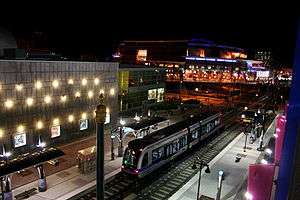
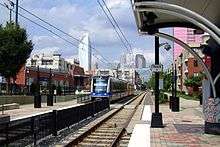
The city of Charlotte has a lower than average percentage of households without a car. In 2015, 7.4 percent of Charlotte households lacked a car, and decreased to 6 percent in 2016. The national average was 8.7 percent in 2016. Charlotte averaged 1.65 cars per household in 2016, compared to a national average of 1.8.[161]
Mass transit
The Charlotte Area Transit System (CATS) is the agency responsible for operating mass transit in Charlotte and Mecklenburg County. CATS operates light rail transit, streetcar, express shuttles, and bus services serving Charlotte and its immediate suburbs. The LYNX light rail system comprises an 18.9‑mile line north–south line known as the Blue Line, which saw 2025 ridership projections (18,500) exceeded after its first year of service. Bus ridership continues to grow (66% since 1998).[162] The 2030 Transit Corridor System Plan looks to supplement established bus service with light rail and commuter rail lines as a part of the LYNX system.
In 2011, the city of Charlotte and CATS staff conducted public forums to present the final Environmental Impact Statement (EIS) and gather public input from residents, property owners, and business owners located in northeast Charlotte, which is where the LYNX light rail was extended from uptown Charlotte to the UNC‑Charlotte campus.[163] This portion of the LYNX light rail was opened on March 16, 2018 to the public.[164]
Walkability
A 2011 study by Walk Score ranked Charlotte the 49th most walkable of the 50 largest cities in the United States.[165]
Roads and highways
Charlotte's central location between the population centers of the northeast and southeast has made it a transportation focal point and primary distribution center, with two major interstate highways, I-85 and I-77, intersecting near the city's center. The latter highway also connects to the population centers of the Rust Belt.
Charlotte's beltway, designated I-485 and simply called "485" by local residents, has been under construction for over 20 years, but funding problems have slowed its progress. The final segment was finished in mid-2015.[166] I-485 has a total circumference of approximately 67 mi (108 km). Within the city, the I-277 loop freeway encircles Charlotte's uptown (usually referred to by its two separate sections, the John Belk Freeway and the Brookshire Freeway) while Charlotte Route 4 links major roads in a loop between I-277 and I-485. Independence Freeway, which carries U.S. 74 and links downtown with the Matthews area, is undergoing an expansion and widening in the eastern part of the city.
Air

Charlotte Douglas International Airport is the sixth busiest airport in both the U.S. and the world overall as measured by traffic (aircraft movements).[167] The airport handled just over 50 million travellers in 2019, as well as many domestic and international carriers including Air Canada, Lufthansa, and Volaris. It is a major hub for American Airlines, having historically been a hub for its predecessors US Airways and Piedmont Airlines. Nonstop flights are available to many destinations across the United States, Canada, Central America, the Caribbean, Europe, Mexico, and South America.[168]
Intercity transportation
Charlotte is served daily by three Amtrak routes with ten daily trips from a station on North Tryon Street, just outside downtown.
- The Crescent connects Charlotte with New York, Philadelphia, Baltimore, Washington, D.C.; Charlottesville, and Greensboro to the north, and Greenville, Atlanta, Birmingham, Meridian and New Orleans to the south. It arrives overnight once in each direction.
- The Carolinian connects Charlotte with New York; Philadelphia; Baltimore; Washington, D.C.; Richmond; Raleigh; Durham; and Greensboro. Charlotte is the southern terminus, with the northbound train leaving just before the morning rush and the southbound train arriving in the evening.
- The Piedmont, a regional companion of the Carolinian, connects Charlotte with Greensboro, Durham and Raleigh with three daily round trips. Charlotte is the southern terminus.
Charlotte is also served by both Greyhound and low-cost curbside carrier Megabus. Charlotte is a service stop for Greyhound routes running to Atlanta, Detroit, Jacksonville, New York and Philadelphia. It is also a stop for buses running out of Megabus' hub in Atlanta, with connections to Megabus' northeastern routes out of New York.
The city is planning a new centralized downtown multimodal station called Gateway Station, It is expected to house Amtrak, Greyhound and the future LYNX Red Line. It is under construction at the former site of the Greyhound station; Greyhound is currently operating from a temporary station nearby.
Notable people
Sister cities
Sister Cities International has designated nine sister cities of Charlotte:[169]
See also
- I-85 Corridor
- List of sites of interest in Charlotte, North Carolina
- May 1989 tornado outbreak
- Urban League of Central Carolinas
Notes
- The corresponding record since the observation site was moved to Charlotte/Douglas International Airport in 1948 is 79 °F (26 °C), last recorded on July 25, 2010.[51]
- Mean monthly maxima and minima (i.e. the expected highest and lowest temperature readings at any point during the year or given month) calculated based on data at said location from 1981 to 2010.
- Official records for Charlotte kept October 1878 to August 1948 at downtown and at Charlotte-Douglas Int'l since September 1948. For more information, see Threadex
References
- "The Mecklenburg Historical Association, Charlotte, NC". meckdec.org. Archived from the original on June 10, 2020. Retrieved June 22, 2020.
- "Charlotte, North Carolina". Geographic Names Information System. United States Geological Survey.
- "2019 U.S. Gazetteer Files". United States Census Bureau. Retrieved July 27, 2020.
- "Population and Housing Unit Estimates". Retrieved May 21, 2020.
- "Annual Estimates of the Resident Population: April 1, 2010 to July 1, 2018". U.S. Census Bureau, Population Division. April 2019. Archived from the original on February 13, 2020. Retrieved June 30, 2019.
- "Annual Estimates of the Resident Population for Incorporated Places of 50,000 or More, Ranked by July 1, 2019 Population: April 1, 2010 to July 1, 2019". United States Census Bureau, Population Division. Retrieved May 21, 2020.
- "Annual Estimates of the Resident Population: April 1, 2010 to July 1, 2018". U.S. Census Bureau. U.S. Census Bureau, Population Division. Archived from the original on February 13, 2020. Retrieved June 30, 2019.
- "Here's Why Charlotte Became The Fastest Growing City in The Country Over The Past Decade". May 2017.
- "Millennial magnet: Charlotte ranks as top city in young-adult population growth". November 2016.
- Balk, Gene (May 22, 2014). "Census: Seattle is the fastest-growing big city in the U.S." Seattle Times. FYI Guy. Archived from the original on February 22, 2018. Retrieved November 28, 2014.
- "The World According to GAWC 2018". GAWC. Retrieved January 20, 2019.
- Staff, CharlotteFive (March 21, 2018). "31 signs you're a native Charlottean". The Charlotte Observer. Archived from the original on June 25, 2020. Retrieved June 22, 2020.
- O'Daniel, Adam (September 4, 2012). "So how did Charlotte become a banking center?". Charlotte Business Journal. The Business Journals. Retrieved June 23, 2015.
- "Question the Queen City: Who were the Native Americans that lived here before Charlotte was colonized?". Creative Loafing Charlotte. Retrieved April 11, 2016.
- "Mecklenburg County (1762)". North Carolina History Project. Archived from the original on June 26, 2020. Retrieved June 23, 2020.
- "The American Revolution in North Carolina". Archived from the original on July 13, 2007. Retrieved June 25, 2011.
- "The Charlotte-Mecklenburg Story: History Timeline: Founding a New City". cmstory.org Web Site. Public Library of Charlotte and Mecklenburg County. Archived from the original on May 18, 2015. Retrieved September 25, 2015.
- Bernstein, Viv. "Welcome to Charlotte, a City of Quirks". The Caucus. New York Times. Retrieved July 29, 2014.
- Charlotte Mecklenburg Library: A Welcome for Cornwallis (Retrieved on 07–25–19)
- "1768- Charlotte Chartered". cmstory.org. Retrieved May 31, 2020.
- "A Compleat map of North-Carolina from an actual survey". library.unc.edu. 1770. Retrieved May 31, 2020.
- "The Charlotte-Mecklenburg Story: History Timeline: Designing a New City". cmstory.org Web Site. Public Library of Charlotte and Mecklenburg County. Archived from the original on May 18, 2015. Retrieved September 25, 2015.
- "101 Independence Center". Archived from the original on June 5, 2008. Retrieved September 25, 2015.
- Beam, Adam (February 12, 2012). "N.C.-S.C. border may move". The State. Archived from the original on February 12, 2012. Retrieved February 29, 2012.
- "The Charlotte-Mecklenburg Story: History Timeline: The City of Churches". cmstory.org Web Site. Public Library of Charlotte and Mecklenburg County. Archived from the original on May 18, 2015. Retrieved September 25, 2015.
- Blanchard Online: American Rarities (Retrieved on 05–22–07)
- "The Charlotte Branch Mint". Blanchardonline.com. Archived from the original on April 19, 2004. Retrieved July 2, 2010.
- "The Charlotte-Mecklenburg Story". cmstory.org Web Site. Public Library of Charlotte and Mecklenburg County. Archived from the original on September 25, 2015. Retrieved September 25, 2015.
- "Survey and Research Report on the Mecklenburg County Courthouse". Charlotte-Mecklenburg Historic Landmarks Commission. Retrieved February 1, 2018.
- "Northwest Almanac: When Winston-Salem was the state's largest city". Winston-Salem Journal. January 8, 2018. Retrieved February 1, 2018.
- "The Charlotte-Mecklenburg Story: History Timeline: NationsBank Soars". cmstory.org Web Site. Public Library of Charlotte and Mecklenburg County. Archived from the original on May 18, 2015. Retrieved September 25, 2015.
- Hurricanedisasterslive.com Archived August 24, 2009, at the Wayback Machine, Retrieved on July 30, 2009
- "Ice Storm Knocks Out Power Across North Carolina". Raleigh, NC: WRAL-TV. December 5, 2002. Retrieved May 18, 2015.
- "Two arrested during Kerrick trial protests in Charlotte". Durham, NC: WTVD. August 22, 2015. Retrieved September 25, 2016.
- Rothacker, Rick; Washburn, Mark; Bell, Adam (September 23, 2016). "Staggered by protests, city regains its footing". The Charlotte Observer. Retrieved September 25, 2016.
- "State of North Carolina Incorporated Places - Current/BAS19 - Data as of January 1, 2018". U.S. Census Bureau, TIGERweb Application. January 1, 2019. Retrieved June 30, 2019.
- "Archive version of neighborhood listing – waybackmachine October 2007". Web.archive.org. October 29, 2007. Archived from the original on October 29, 2007. Retrieved October 2, 2013.
- "Biddleville Five Points Neighborhood". Charlotte-Mecklenburg Historic Landmarks Commission. Archived from the original on September 13, 2012. Retrieved September 12, 2012.
- "History – Plaza Midwood Neighborhood Association". Plaza Midwood Neighborhood Association. Archived from the original on November 4, 2012. Retrieved September 12, 2012.
- "NoDa – Urban Explorers Handbook". Creative Loafing Charlotte. Retrieved September 12, 2012.
- Cutchin, A.M. (October 13, 2018). "Myers Park: Tradition and Beauty, Minutes from Downtown Charlotte". mansionglobal.com. Archived from the original on October 13, 2018. Retrieved October 13, 2018.
- MacLaughlin, Courtney (April 25, 2018). "Not a one-trick pony: the 5 best things about living in SouthPark". charlottefive.com. Archived from the original on June 25, 2020. Retrieved April 25, 2018.
- "Forecasting Urbanization in the Carolina Piedmont Region". UNC Charlotte Urban Institute. Archived from the original on June 30, 2010. Retrieved September 12, 2012.
- Grande DIsco – Charlotte, NC – Abstract Public Sculptures on. Waymarking.com. Retrieved on August 25, 2013.
- Addie Rising (September 12, 2012). "Getting to Know Charlotte's SouthPark Neighborhood".
- "Park Road Park". Charmeck.org. Archived from the original on December 13, 2011. Retrieved July 12, 2018.
- "That page does not exist - LatinoYP". Hellocharlotte.com. Archived from the original on October 16, 2017. Retrieved February 22, 2017.
- "Little Sugar Creek Greenway section is done". CharlotteObserver.com. July 22, 2012. Archived from the original on July 22, 2012.
- Sellers, Frances Stead (November 26, 2019). "One city's plan to combat climate change: Bulldoze homes, rebuild paradise". Washington Post. Archived from the original on November 27, 2019. Retrieved December 20, 2019.
- "USDA Plant Hardiness Zone Map". United States Department of Agriculture. Archived from the original on February 27, 2014. Retrieved June 1, 2014.
- "NowData – NOAA Online Weather Data". National Oceanic and Atmospheric Administration. Retrieved March 7, 2020.
- "Station Name: NC CHARLOTTE DOUGLAS AP". National Oceanic and Atmospheric Administration. Retrieved September 4, 2016.
- "WMO Climate Normals for CHARLOTTE/DOUGLAS INT'L ARPT NC 1961–1990". National Oceanic and Atmospheric Administration. Retrieved July 18, 2020.
- "Charlotte, North Carolina, USA - Monthly weather forecast and Climate data". Weather Atlas. Retrieved June 14, 2019.
- "Annual Estimates of the Population for Incorporated Places Over 100,000". U.S. Census Bureau. Archived from the original on February 13, 2020. Retrieved June 30, 2019.
- Bureau, U. S. Census. "U.S. Census website". United States Census Bureau. Retrieved June 30, 2019.
- "US Census Bureau Quick Facts". US Census Bureau. Retrieved July 2, 2015.
- "North Carolina – Race and Hispanic Origin for Selected Cities and Other Places: Earliest Census to 1990". U.S. Census Bureau. Archived from the original on August 12, 2012. Retrieved April 16, 2012.
- "The Association of Religion Data Archives – Maps & Reports". Thearda.com. Archived from the original on June 2, 2016. Retrieved June 13, 2016.
- Joe Marusak (2013). "Elevation Church eyes old Palace Theater in Cornelius for another location". Retrieved May 16, 2013.
- Michael Gordon (2012). "Two Charlotte churches are expanding, defying decline of religion". Archived from the original on November 9, 2013. Retrieved July 15, 2013.
- "About us – Holy Trinity Cathedral". htgo.org. Archived from the original on June 27, 2020. Retrieved June 23, 2020.
- Foundation of Shalom Park – Charlotte. Shalomcharlotte.org. Retrieved on August 25, 2013.
- "Charlotte, North Carolina Religion". Bestplaces.net. Retrieved June 13, 2016.
- https://www.charlotteobserver.com/news/business/banking/article221589840.html
- Carrizales, Jennifer. "Charlotte Soars to Become the Nation's Second Largest Financial Center". North Carolina History Projects. Retrieved July 13, 2018.
- "Bank of America Financial Centers and ATMs in Charlotte, NC". Bank of America. Archived from the original on June 26, 2020. Retrieved June 23, 2020.
- Craver, Richard (April 1, 2020). "Truist completes $455.5M purchase of Charlotte HQ; bank delays new branding unveilings". Winston-Salem Journal. Retrieved June 23, 2020.
- "Microsoft East Coast Headquarters - Safway Services". safway.com. Archived from the original on March 29, 2017. Retrieved March 28, 2017.
- Smoot, Hannah (October 25, 2019). "Microsoft investing $24 million in Charlotte campus, creating over 400 high-paying jobs". charlotteobserver.com. Retrieved November 23, 2019.
- https://www.charlotteobserver.com/news/business/article243910837.html
- "Fortune 500 (2019)". Retrieved August 25, 2019.
- Charlotte Chamber of Commerce. "270 Fortune 500 Companies Represented in Charlotte-Mecklenburg" (PDF). Retrieved August 25, 2014.
- "U.S. National Whitewater Center :: Whitewater Rafting, Biking, Climbing, Kayaking, Zip lines, Food, and Fun. – Come Play!". Usnwc.org. Retrieved July 2, 2010.
- "Overview – Energy Production & Infrastructure Center". epic.uncc.edu. Archived from the original on June 26, 2020. Retrieved June 23, 2020.
- "Metropolitan Charlotte North Carolina | MetTerrace Townhomes | MetLoft Condos | MetClub Resort | Residential Urban Living North Carolina". Metmidtown.com. Retrieved July 2, 2010.
- "Best Places For Business and Careers — Forbes". Forbes. Retrieved January 16, 2014.
- "Charlotte vs. Raleigh Statistics — Carolina Ad Group". Carolinaadgroup.com. Archived from the original on June 13, 2014. Retrieved June 6, 2014.
- "Major Employers in Charlotte Region - Charlotte Area Major Employers (Q2 2018)" (PDF). Charlotte Regional Business Alliance. Retrieved August 24, 2019.
- "About The Bechtler Museum of Modern Art". m.bechtler.org. Retrieved November 24, 2019.
- "What is the Library – The Billy Graham Library". billygrahamlibrary.org. November 23, 2019. Retrieved November 23, 2019.
- "About the Carolinas Aviation Museum". carolinasaviation.org. November 22, 2019. Retrieved November 23, 2019.
- "About the Gantt". ganttcenter.org. November 23, 2019. Retrieved November 24, 2019.
- "Our History". museumofthenewsouth.org. November 23, 2019. Retrieved November 24, 2019.
- "Our 40–Year History". lightfactory.org. November 23, 2019. Retrieved November 24, 2019.
- "About McColl". mccollcenter.org. November 23, 2019. Retrieved November 24, 2019.
- "About the Mint Museum". mintmuseum.org. November 23, 2019. Archived from the original on December 30, 2019. Retrieved November 23, 2019.
- "About the Hall – NASCAR Hall of Fame". nascarhall.com. November 23, 2019. Retrieved November 23, 2019.
- "Second Ward High School Foundation". secondwardfoundation.org. November 23, 2019. Retrieved November 24, 2019.
- "About – Charlotte museum". charlottemuseum.org. November 23, 2019. Retrieved November 24, 2019.
- "Actor's Theatre of Charlotte". atcharlotte.org. November 23, 2019. Retrieved November 25, 2019.
- "Charlotte Ballet: History". charlotteballet.org. November 23, 2019. Retrieved November 24, 2019.
- "About imaginon". imaginon.org. November 23, 2019. Retrieved November 25, 2019.
- "The History of Opera Carolina". operacarolina.org. November 23, 2019. Retrieved November 24, 2019.
- "Quick Facts – Carolina Renaissance festival". carolina.renfestinfo.com. November 25, 2019. Retrieved November 25, 2019.
- "Opa! it's time for the Yiasou Greek Festival". wsoctv.com. August 29, 2014. Retrieved November 25, 2019.
- "41st Yiasou Greek Festival kicks off in Charlotte". spectrumlocalnews.com. September 6, 2018. Retrieved November 25, 2019.
- Giles, Alex (June 7, 2019). "Night one of Taste of Charlotte draws big crowds despite earlier rainy weather". wbtv.com. Retrieved November 25, 2019.
- "Moo and Brew Festival". mooandbrewfest.com. November 24, 2019. Retrieved November 25, 2019.
- "Breakaway Music Festival Returns to Charlotte". Charlotte Concert Guide. June 3, 2019.
- "Heroescon: History". heroesonline.com.
- "Thousands come out for Charlotte Pride Festival in uptown". wcnc.com. August 18, 2019. Retrieved December 16, 2019.
- Price, Mark (August 25, 2017). "Charlotte's largest annual parade is now the gay-themed Charlotte Pride". charlotteobserver.com. Retrieved December 16, 2019.
- "About the Charlotte Zoological Park Initiative | Bringing Animal Conservation & Research to the Carolinas". Charlottezoologicalpark.org. Archived from the original on January 31, 2011. Retrieved October 2, 2013.
- "Charlotte Zoological Park Initiative ready to move forward — News 14". Charlotte.news14.com. Archived from the original on June 29, 2013. Retrieved October 2, 2013.
- "Great zoos". CharlotteObserver.com. May 16, 2013. Archived from the original on April 16, 2014. Retrieved October 2, 2013.
- "Sea Life Aquarium opens at Concord Mills". CharlotteObserver.com. February 20, 2014. Archived from the original on February 22, 2014. Retrieved February 20, 2014.
- "Charlotte Mecklenburg Library Info". cmlibrary.org. November 23, 2019. Retrieved November 24, 2019.
- "Public Library of Charlotte and Mecklenburg County: A century of service". cmstory.org Web Site. Public Library of Charlotte and Mecklenburg County. Archived from the original on September 25, 2015. Retrieved September 25, 2015.
- "Public Library of Charlotte and Mecklenburg County: A century of service". cmstory.org Web Site. Public Library of Charlotte and Mecklenburg County. Archived from the original on September 25, 2015. Retrieved September 25, 2015.
- "Public Library of Charlotte and Mecklenburg County: A century of service". cmstory.org Web Site. Public Library of Charlotte and Mecklenburg County. Archived from the original on September 25, 2015. Retrieved September 25, 2015.
- "charmeck.org Web Site". Archived from the original on October 6, 2007. Retrieved September 25, 2015.
- "Carolina Panthers Team History". profootballhof.com. November 26, 2019. Retrieved November 26, 2019.
- "The Official Website of The Charlotte Hornets". Hornets.com. NBA Media Ventures, LLC. May 20, 2014. Retrieved November 23, 2019.
- "About Spectrum Center". spectrumcentercharlotte.com. November 25, 2019. Archived from the original on December 26, 2019. Retrieved November 26, 2019.
- "Carolina Panthers Franchise Encyclopedia". Pro-Football Reference.Com. Retrieved June 23, 2020.
- Spanberg, Erik. "George Shinn says co-owner 'hell-bent' on Charlotte exit". Bizjournals.com. Charlotte Business Journal. Retrieved May 14, 2015.
- "Charlotte Hornets – 30th Anniversary Season". hornets30.com. Charlotte Hornets. Retrieved February 16, 2019.
- NBA owners give Bobcats OK to change name to Charlotte Hornets, The Charlotte Observer, July 19, 2013
- "Hornets all the buzz in Charlotte". ESPN.com. Associated Press. May 20, 2014. Retrieved June 23, 2020.
- "Charlotte Hornets on Twitter". Twitter. Retrieved June 13, 2016.
- Newton, David (December 17, 2019). "Charlotte gets MLS' 30th franchise for record $325 million". ESPN. Retrieved December 17, 2019.
- Newton, David (July 9, 2018). "Sale of Panthers to David Tepper is finalized". espn.com. Retrieved November 23, 2019.
- "NJCAA". NJCAA. Retrieved August 22, 2019.
- "Big South Conference Quick Facts". bigsouthsports.com. November 26, 2019. Retrieved November 26, 2019.
- Bonnell, Rick (May 24, 2017). "Charlotte to host 2019 NBA All-Star Game". charlotteobserver.com. Retrieved November 24, 2019.
- "ACC Men's Basketball Tournament set for Charlotte this week". fox46charlotte.com. March 12, 2019. Retrieved November 24, 2019.
- Scott, David (July 30, 2016). "1 year away, Quail Hollow Club, Charlotte poised to host PGA Championship". newsobserver.com. Retrieved November 25, 2019.
- "Mayor". City of Charlotte Government. Retrieved April 13, 2020.
- "Cannon sworn in as Mayor". WBTV. December 2, 2013. Retrieved December 2, 2013.
- Washburn, Mark; Morrill, Jim. "Charlotte mayor resigns after arrest on corruption charges". Charlotteobserver.com. Retrieved June 13, 2016.
- WBTV. "Dan Clodfelter selected as mayor of Charlotte". Dan Clodfelter selected as mayor of Charlotte. WBTV. Retrieved April 7, 2014.
- Berky, Rad (November 8, 2017). "Vi Lyles wins Charlotte mayoral race". wcnc.com. Retrieved November 25, 2019.
- Mueller, Eleanor (July 20, 2018). "Charlotte to host 2020 Republican National Convention". politico.com. Retrieved November 24, 2019.
- "Largest 100 School Districts". Proximityzone.com. Retrieved June 13, 2016.
- "Charlotte NC- Three Big Wins for the City". Charlotte Communities Online. December 10, 2009. Archived from the original on August 6, 2016. Retrieved August 5, 2016.
- "Media.newsoberver.com". Archived from the original on October 31, 2007.CS1 maint: BOT: original-url status unknown (link)
- "Background, Facts and History". Cms.kj12.nc.us. Archived from the original on June 2, 2016. Retrieved June 13, 2016.
- "Distinctly Davidson". davidson.edu. Archived from the original on June 13, 2020. Retrieved June 22, 2020.
- "About us – UNC Charlotte". uncc.edu. November 23, 2019. Retrieved November 23, 2019.
- "About CPCC — CPCC". Cpcc.edu. Retrieved June 13, 2016.
- Olson, Elizabeth (August 15, 2017). "For–Profit Charlotte School of Law Closes". nytimes.com. Retrieved November 23, 2019.
- "Wake Forest University plans for growth and increases commitment in Charlotte". Wake Forest University. May 22, 2009. Archived from the original on June 10, 2009. Retrieved May 22, 2009.
- "N.C. Research Campus Partners and Research". Archived from the original on March 4, 2014. Retrieved May 20, 2013.
- "About us". The Charlotte Observer. Archived from the original on June 27, 2020. Retrieved February 6, 2015.
- "Biggest North Carolina Newspapers". Mondotimes.com. Retrieved March 26, 2018.
- "About WFAE". wfae.org. Archived from the original on June 26, 2020. Retrieved June 23, 2020.
- "Local Television Market Universe Estimates" (PDF). Nielsen. January 1, 2017.
- "2017 Annual Report" (PDF). Medic911.com. Archived from the original (PDF) on May 15, 2018. Retrieved July 12, 2018.
- "City of Charlotte – Fire". charlottenc.gov. Retrieved February 16, 2020.
- "Home". Charmeck.org. Archived from the original on June 5, 2008. Retrieved July 2, 2010.
- "Charlotte, North Carolina (NC) profile: population, maps, real estate, averages, homes, statistics, relocation, travel, jobs, hospitals, schools, crime, moving, houses, sex offenders, news, sex offenders". City-data.com. Retrieved July 2, 2010.
- Charlotte, NC Auto Theft Statistics, archived from the original on June 6, 2014, retrieved June 6, 2014
- "CQ Press: City Crime Rankings 2008". Os.cqpress.com. Archived from the original on June 7, 2010. Retrieved July 2, 2010.
- "AMSAFM2.WK4" (PDF). Archived from the original (PDF) on March 26, 2009. Retrieved July 2, 2010.
- "Charlotte Utilities — Home". Charmeck.org. Retrieved October 2, 2013.
- "Charlotte Water". City of Charlotte Government. Retrieved March 26, 2018.
- "Controversial 'sludge' disposal draws friends, foes in four S.C. counties". Wrhi.com. February 26, 2013. Retrieved October 2, 2013.
- "News Release Archive | The Carlyle Group". Carlyle.com. Retrieved March 26, 2018.
- EPA, OW, OST, HECD, US. "Biosolids | US EPA". US EPA. Retrieved March 26, 2018.CS1 maint: multiple names: authors list (link)
- "Car Ownership in U.S. Cities Data and Map". Governing. Retrieved May 4, 2018.
- Charlotte.com
- "LYNX Blue Line Extension". Charlotte Area Transit System. Retrieved May 27, 2013.
- "After a decade of planning, Charlotte's light-rail extension finally opens". charlotteobserver. Retrieved July 7, 2018.
- "2011 City and Neighborhood Rankings". Walk Score. 2011. Retrieved August 28, 2011.
- "NCDOT: I-485 Charlotte Outer Loop". Ncdot.gov. Archived from the original on June 21, 2016. Retrieved June 13, 2016.
- "Release ACI World Airport Traffic" (PDF). Charmeck.org. Archived from the original (PDF) on August 16, 2013.
- "About CLT". cltairport.com. Retrieved June 21, 2020.
- "Charlotte International Cabinet". Charmeck.org. Archived from the original on April 25, 2012. Retrieved July 2, 2010.
Further reading
- Graves, William, and Heather A. Smith, eds. Charlotte, NC: The Global Evolution of a New South City (University of Georgia Press; 2010) 320 pages. Essays that use Charlotte to explore how globalization and local forces combine to transform Southern cities. ISBN 0-8203-3561-4
- Hanchett, Thomas W. Sorting Out the New South City: Race, Class, and Urban Development in Charlotte, 1875–1975. 380 pages. University of North Carolina Press. August 1, 1998. ISBN 0-8078-2376-7.
- Kratt, Mary Norton. Charlotte: Spirit of the New South. 293 pages. John F. Blair, Publisher. September 1, 1992. ISBN 0-89587-095-9.
- Kratt, Mary Norton and Mary Manning Boyer. Remembering Charlotte: Postcards from a New South City, 1905–1950. 176 pages. University of North Carolina Press. October 1, 2000. ISBN 0-8078-4871-9.
- Kratt, Mary Norton. New South Women: Twentieth Century Women of Charlotte, North Carolina. Public Library of Charlotte and Mecklenburg County in Association with John F. Blair, Publisher. August 1, 2001. ISBN 0-89587-250-1.
External links
| City | County / District / Region / State | Country | Date |
|---|---|---|---|
| Arequipa | 1962 | ||
| Krefeld | 1985 | ||
| Baoding | Hebei | 1987 | |
| Voronezh | 1991 | ||
| Limoges | 1992 | ||
| Wroclaw | 1993 | ||
| Kumasi | 1996 | ||
Articles relating to Charlotte, North Carolina | |
|---|---|
